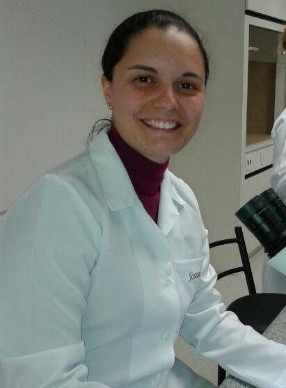By Darliane Evangelho Silva, Joseane Moreira do Nascimento and Noeli Juarez Ferla
Wine production occupies an area of more than 80 thousand hectares distributed in six regions in Brazil (Ibravin, 2018). The state of Rio Grande do Sul accounts for approximately 90% of the national production (Ibravin, 2016). The spider mite Panonychus ulmi (Koch) (Tetranychidae) causes damage to grapevines in this region, causing loss of chlorophyll in the sites attacked, browning, and reddish speckling on the adaxial face of leaves and in severe attacks, can cause premature leaf falls (Ferla and Botton, 2008; Moraes and Flechtmann, 2008) or lower photosynthetic activity post-harvest, thus reducing the accumulation of reserves between harvests (Schruft, 1985) (Figure 1).

Neoseiulus californicus McGregor (Phytoseiidae) is a predatory mite widely distributed worldwide (McMurtry and Croft, 1997) and used in applied biological control programs of tetranychids in grapevines and another crops. This mite is naturally present in grapevines in Brazil, considered tolerant to some insecticides and fungicides (Monteiro, 2002; Escudero and Ferragut, 2005; Liburd et al., 2007; Toldi et al., 2013). Large populations develop in this region in the middle of summer, showing significant correlation with P. ulmi population (Johann and Ferla, 2012).
We performed a study to determine the effects of 13 agrochemicals, frequently used in vineyards, against P. ulmi and N. californicus. Experimental design was completely randomized with 15 replicates/treatment. The evaluations were conducted with uniform-age mites. Foliar discs (5 cm diameter) were cut with a punch and sprayed (0.5 mL) with agrochemicals using a professional SW-775 air-brush (working pressure from 10 to 45 psi), at a distance of 15 cm inside a cabin vertical laminar flow. After spraying, the discs were exposed to the environment on a paper towel for approximately one hour to dry and were placed on a moistened cotton disc inside a Petri dish with 6.5 cm diameter. Thus, P. ulmi females were transferred to the arenas (Figure 2).

The effect on P. ulmi females did evaluate in five days, while the evaluation on N. californicus lasted eight days, where dead females were counted and removed daily. Distilled water was used for the control group. The corrected mortality rate and the effect of products on mite reproduction were evaluated and eggs were monitored until larval hatching to evaluate viability. Products were classified according to the total effect caused, in toxicity classes proposed by the IOBC/WPRS Working Group “Pesticides and beneficial organisms”.
Overall, mortality rate increase for all products, mostly after 72 h. Lambda-cyhalothrin caused the highest mortality rate after 24 h, reaching a total mortality at 72 h. Copper hydroxide (23.5%), mancozeb (30.8%), imidacloprid (33.8%), and azoxystrobin (42.6%) caused the lowest mortality rates, whereas the other agrochemicals caused a higher mortality, with emphasis on lambda-cyhalothrin (100%), followed by abamectin (79.4%) and famoxadone + mancozeb (75%). Lambda-cyhalothrin had the highest effect on viability (6.7%), followed by copper sulphate (65.2%). In the presence of the other products, P. ulmi viability was higher than 90% (Table 1).

The total effect was higher when cymoxanil + mancozeb, tetraconazole, lambda-cyhalothrin, and famoxadone + mancozeb were applied, and a lower effect occurred in the presence of metirame + pyraclostrobin. Approximately 40% proved to be slightly harmful (azoxystrobin, metirame + pyraclostrobin, copper hydroxide, mancozeb, imidacloprid), 30% were moderately harmful (abamectin, copper sulphate + lime, sulphur, tebuconazole), and 30% were harmful (cymoxanil + mancozeb, tetraconazole, lambda-cyhalothrin, famoxadone + mancozeb). Therefore, none of the products evaluated in this study proved to be harmless for N. californicus (Table 2).

The results obtained in this study corroborate the hypothesis that agrochemicals which are frequently applied in vineyards cause a higher mortality rate to the predatory mite N. californicus than that of its prey, P. ulmi. This fact confirms the hypothesis that the use of the pesticides evaluated here benefits the populations of phytophagous mite rather than the populations of its natural enemy, favoring thus pest outbreaks because of predator reduction or extinction. The conditions are more controlled in the laboratory, whereas in the field these products may possibly have their capacity of controlling phytophagous mites diminished, i.e., the effects could be lower in field conditions.
Choosing selective products of the natural enemy and understanding what happens with the phytophagous mites are important tools in maintaining the predatory mite fauna present, thus avoiding the indiscriminate use of agrochemicals. Preventing harmful agrochemicals to predators from being used is an essential tool in the decision-making process when there is the need for controlling organisms that attain pest status. The study is available at https://doi.org/10.1016/j.cropro.2019.05.014.

Darliane Evangelho Silva. Graduated in Biological Sciences, Master and PhD in Sciences (Environment and Development) from the University of Vale do Taquari – Univates, Brazil. Currently is a postdoctoral student with a Postdoctoral Junior Scholarship – CNPq, linked to the Postgraduate Program in Environment and Development and the Laboratory of Acarology (Labacari) at the University of Vale do Taquari, develops her research with the impact of agrochemicals on phytophagous mites and predators in vineyards in the South of Brazil.

Joseane Moreira do Nascimento. PhD student and MSc in Biotechnology and graduate in Biological Sciences by University of Vale do Taquari – Univates. Is currently completing the Sandwich PhD abroad with a one-year PDSE CAPES scholarship at the ICVV (Instituto de Ciencias de La Vid e del Vino), Logroño Spain. Has experience in molecular analysis of mites with agricultural importance and its ecology, works with phytophagous mites found in grapevines and also has experience in routines and laboratory analyzes of human molecular diagnostics.

Noeli Juarez Ferla. Graduated in Biological Sciences from the University of Vale do Rio dos Sinos (Unisinos), MSc in Biosciences from the Pontifical Catholic University of Rio Grande do Sul (PUC/RS) and PhD in Sciences from the University of São Paulo (ESALQ/USP). Post-doctorate from the University of Amsterdam, Netherlands and Senior Internship at the University of Bari, Italy. Professor of Univates. He has experience in the area of Zoology, with emphasis in Acarology, working mainly in the following subjects: biological control, taxonomy and systematics of mites and ecology of mites of the families Phytoseiidae, Stigmaeidae and Tetranychidae. Member of the Advisory Committee of the Agricultural Sciences area of FAPERGS. Permanent Professor of Postgraduate Programs in Environment and Development (PPGAD) and Biotechnology (PPGBiotec). Coordinates the Postgraduate Program in Sustainable Environmental Systems (PPGSAS).
References
- Escudero, L.A., Ferragut, F., 2005. Life history of predatory mites Neoseiulus californicus and Phytoseiulus persimilis (Acari: Phytoseiidae) on four spider mite species as prey, with special reference to Tetranychus evansi (Acari: Tetranychidae). Biol. control. 32(3), 378-384.
- Ferla, N.J., Botton, M., 2008. Ocorrência do ácaro vermelho europeu associado à cultura da videira no Rio Grande do Sul, Brasil. Ciênc. Rural. 38(6), 1758-1761.
- Ibravin, Instituto Brasileiro do Vinho (2018). Available in: http://www.ibravin.org.br/admin/arquivos/downloads/1499460726.pdf.
- Ibravin, Instituto Brasileiro do Vinho (2016). Available in: http://www.ibravin.org.br/admin/arquivos/estatisticas/1473079559.pdf.
- Johann, L., Ferla, N.J., 2012. Mite (Acari) population dynamics in grapevines (Vitis vinifera) in two regions of Rio Grande do Sul, Brazil. Int. j. acarol. 38(5): 386-393
- Liburd, O.E., White., J.C., Rhodes, E.M., Browdy., A.A., 2007. The residual and direct effects of reduced-risk and conventional miticides on twospotted spider mites, Tetranychus urticae (Acari: Tetranychidae) and predatory mites Acari:Phytoseiidae). Fla. Entomol. 90(1), 249-257.
- McMurtry, J.A., Croft, B.A., 1997. Life-styles of phytoseiid mite and their roles in biological control. Ann Rev Entomol. 42, 291–321.
- Monteiro, L.B., 2002. Manejo integrado de pragas em macieira no Rio Grande do Sul. Uso de Neoseiulus californicus para o controle de Panonychus ulmi. Rev. Bras. Frutic. 24 (2), 395-405.
- Moraes, G.J., Flechtmann, C.H.W., 2008. Manual de Acarologia: acarologia básica e ácaros de plantas cultivadas no Brasil. Ribeirão Preto: Holos, Editora. pp. 288.
- Schruft, G.A. In: Helle. W., Sabelis, M.W., 1985. Spider mites: Their biology, natural enemies and control. Amsterdan. Elsevier. pp. 359-366.
- Toldi, M., Ferla, N.J., Dameda, C., Majolo, F., 2013. Biology of Neoseiulus californicus feeding on two-spotted spider mite. Biotemas. 26(2), 105-111.

